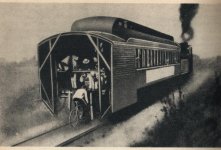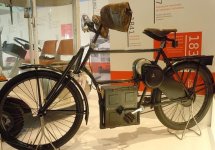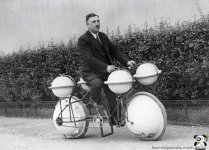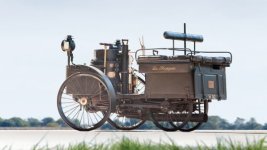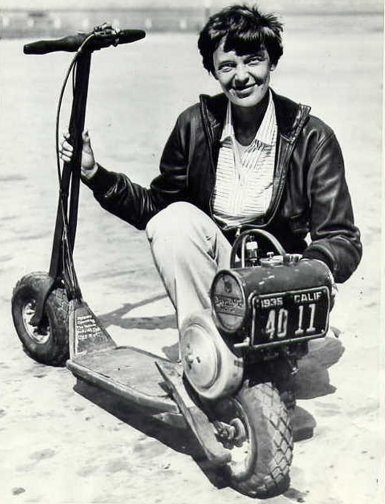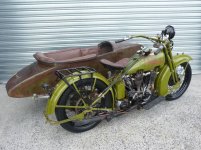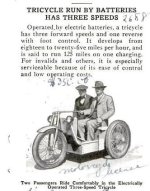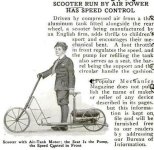Roper Steam Cycle set to become most expensive motorcycle ever sold at auction
By Mike Hanlon
04:32 October 28, 2011
One of the world's most valuable motorcycles will go under the hammer early next year. It was hand-built by American inventor Sylvester H. Roper, one of two people with legitimate claims of inventing the motorcycle.
Though built in 1894, 27 years after the first Roper Steam Motorcycle, the machine is one of a very small number of motorcycles built by Roper (around nine), and was ridden by him regularly before his death in 1896 - he died of a heart attack while demonstrating a bike very similar to that which will be auctioned.
The Roper Steam Cycle hence has a provenance of massive historical importance, and is expected to establish a new world record for a motorcycle sold at auction in Las Vegas on January 12 - 14.
There are two contenders for the world's first motorcycle, each with a raft of supporters. Frenchman Pierre Michaux and American inventor Sylvester Roper can both lay claim to having built the world's first motorcycle, though some argue neither are eligible.
Some very esteemed writers on the subject contend that two-wheelers with steam engines and/or electric engines don't qualify as motorcycles. In the consistently excellent TheVintagent, Paul d'Orléans takes the same line that I do - any form of motive power will do, and I have not done enough research on the subject, I'll call it a tie until there's more information.
My favourite all-time motorcycle writer, Kevin Cameron, accepts only the internal combustion engine for a motorcycle, writing "History follows things that succeed, not things that fail."
In a few decades, the internal combustion engine will also fail, and be replaced by another cleaner power source, and I am sure that the last 125 years will not be erased from the history books, so that's just erroneous thinking. If Cameron is correct, the first motorcycle was built by Gottlieb Daimler and Wilhelm Maybach in 1885.
There's another school of thought that says Michaux should be credited with the first motorcycle design because he patented his in 1869, even though there's no record of a running vehicle prior to 1871. That's it above.
Roper's first machine (pictured above) unquestionably ran on public roads in 1867 though, and it seems unfair to exclude what was clearly a working design simply because it didn't have a patent. Why he did not patent the machine, we will probably never know. Hence until more information comes along, I think it's fair that both be considered legitimate contenders.
Interestingly, both inventors can claim a number of other inventions and notable firsts.
Michaux learned his construction skills as a blacksmith but his design genius can be seen in the most prolific form of transport in history - the bicycle. His company, Michaux et Cie (Michaux and company), was the first company to construct bicycles with pedals (above) and his son Ernest fitted a small steam engine to one of the 'velocipedes' some time in 1867.
Also in 1867 (an idea whose time has come ...), American, Sylvester Roper of Massachusetts developed a twin cylinder steam velocipede with the conrods connected directly to the rear (driving) wheel, just as the world's first three wheeler, the Le Fardier de Cugnot had done in 1769 (though its driving wheel was at the front).
Roper was undoubtedly blessed with remarkable intelligence and mechanical aptitude. At age 12 in 1835, he read about the Newcomen steam engine and the development work being done around the world and built one of his own design, though he had never seen one. Indeed, he had built a full locomotive engine at age 14 (1837) before he saw another steam engine.
His first patent was filed just prior to his twentieth birthday in 1842, for a new and improved method for manufacturing padlocks and it appears he continued to develop not just patentable inventions, but manufacturing machinery throughout his life.
In 1854, he moved to Massechussets and began working at the Springfield Armory, America's sole producer of military equipment and one of the world's leading technological thinktanks at the time.
Established by George Washington, the Springfield Armory was America's first National Armory and the innovative nature of thinking there was responsible for many business innovations of global importance, including interchangeable parts, the mass-production assembly line style and hourly wages.
Roper was a prolific inventor across many fields, and as well as continuing his work on hot air engines (he was regularly seen on Massachusetts roads in his road-going steam car during 1863), he patented many versions of his vehicles.
One successful invention was a Handstitch Sewing Machine, though his work at Springfield Armory during the Civil War saw him join many of history's most fertile minds in producing battlefield weapons using the latest technologies available.
One of Roper's military inventions was the first shotgun choke - exchangeable, threaded, barrel-mounted venturi that could vary the shot spread to achieve maximum effectiveness in different conditions. Others included an improved repeating shotgun mechanism and an improved shotgun loading mechanism.
His first motorcycle of 1867, in the same year as Michaud's, was used the by the Hanlon Brothers during their travelling velo-gymnast displays at county fairs and the like.
The machine to be auctioned, is from Roper's second attempt at building a steam-powered two-wheeler. In 1894, a full decade and a half after Roper turned his hand to other business, he was commissioned by Albert Augustus Pope to build an updated Steam Velocipede based on Pope's 'Columbia' safety-bicycle frame.
The Columbia used pneumatic 'Dunlop' tires, and two such machines were built, one being the bike to go under the hammer on January 12 while the other on long-term display at the Smithsonian Institute.
Remarkably, it has a known, unbroken history from new. Regularly used by Roper, it averaged a record speed of 40 miles per hour on the Dorchester Road in Boston for a measured mile in May 1896.
Following Roper's passing in 1896, the motorcycle was sold by one of his heirs to a Long Island museum and after moving through a series of other museums, including America's Circus City Museum and Bellm's Cars of Yesterday, formed part of two prominent private collections. The current owner acquired the historic motorcycle in 1996 and has seldom lent it for display, with its most recent showing at the Motorcycle Hall of Fame in Pickerington, Ohio, where it helped to celebrate the induction of Sylvester Hayward Roper, America's first motorcyclist.
Auctions America Las Vegas Premier Motorcycle Auction will be held January 12 - 14, 2012 at the Rio All-Suite Hotel & Casino, 3700 W. Flamingo Road, Las Vegas, Nevada.
http://www.auctionsamerica.com/
The current world record for a motorcycle sold at auction is held jointly by a 1915 Cyclone Board Track Racer OHC, which sold for US$551,200 in 2008 and a Brough Superior SS100 which sold in October 2010 for GBP286,000.
http://www.gizmag.com/brough-superior-the-worlds-most-expensive-motorcycle/17318/
Due to currency fluctuations, the Brough Superior's GBP286,000 equated to US$450,188 at the time of its sale, while the Cyclone's US$551,200 equated to GBP278,400 in imperial currency. So there are two "most expensive" motorcycles at present and the Roper will almost certainly break both records if it meets reserve.



